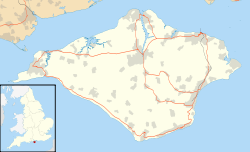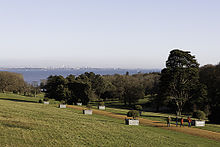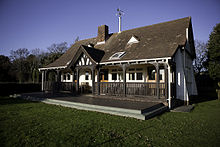- Osborne House
-
Osborne House 
Queen Victoria's Royal Residence North facadeGeneral information Architectural style Italian Renaissance Town or city East Cowes Country England Coordinates 50°45′02″N 1°16′11″W / 50.750546°N 1.269730°W Construction started 1845 Completed 1851 Design and construction Architect Prince Albert - designer Engineer Thomas Cubitt - builder Osborne House is a former royal residence in East Cowes, Isle of Wight, UK. The house was built between 1845 and 1851 for Queen Victoria and Prince Albert as a summer home and rural retreat. Prince Albert designed the house himself in the style of an Italian Renaissance palazzo. The builder was Thomas Cubitt, the London architect and builder whose company built the main façade of Buckingham Palace for the royal couple in 1847. An earlier smaller house on the site was demolished to make way for a new and far larger house.
Queen Victoria died at Osborne House in January 1901. Following her death, the house became surplus to royal requirements and was given to the state with a few rooms retained as a private royal museum dedicated to Queen Victoria. From 1903 until 1921 it was used as a junior officer training college for the Royal Navy known as the Royal Naval College, Osborne. Today it is fully open to the public.
Contents
History
Queen Victoria and her husband Prince Albert bought Osborne House on the Isle of Wight in October 1845. They were searching for a home away from the stresses of court life. Queen Victoria had spent two holidays on the Isle of Wight as a young girl. The setting of the existing three storey Georgian house appealed to Queen Victoria and Prince Albert; in particular, the views of the Solent reminded Albert of the Bay of Naples in Italy. It soon became obvious that it was too small for their needs. Pulling down the house and building a new residence was deemed to be the appropriate course of action.[1]
The new Osborne House was built in the style of the Italian Renaissance complete with two belvedere towers between 1845 and 1851. Prince Albert designed the house himself in conjunction with builder Thomas Cubitt,[1] the London architect and builder whose company also built the main façade of Buckingham Palace. The sale of the Royal Pavilion at Brighton paid for much of the new house's furnishings.[2]
The house consisted of the original square wing known as 'The Pavilion', which contained the principal and royal apartments. The apartments contain reminders of Victoria's dynastic links with the other European royal families. The Billiard Room houses a massive porcelain vase, which was a gift of the Russian Tsar. The grandeur of the Billiard Room, Queen's Dining Room and the Drawing Room on the ground floor forms a marked contrast with the much more homely and unassuming decor of the royal apartments on the first floor. These rooms contain the Prince's Dressing Room, the Queen's Sitting Room, The Queen's Bedroom and the children's nurseries, were intended for private, domestic use, and were therefore as comfortable as possible. Both Queen Victoria and Prince Albert were determined to bring up their children in as natural and loving environment as their situation allowed so that as a consequence the royal children visited their parents' bedrooms when other children of a similar status lived in a far more detached manner.[3]
The 'main wing', containing the household accommodation and council and audience chambers, was added later. The final addition to the house was a wing built between 1890 and 1891. It contains on the ground floor the famous Durbar Room which is named after an anglicised version of the Hindi word darbar. This word means court. The Durbar Room was built for state functions and decorated by Bhai Ram Singh in an elaborate and intricate style, with a carpet from Agra. It now contains the gifts Queen Victoria received on her Golden and Diamond Jubilees. These include engraved silver and copper vases, Indian armour and even a model of an Indian palace.[4] The first floor of the new wing was for the sole use of Princess Beatrice and her family. Beatrice was the Queen's youngest daughter, who remained permanently at her side.
The Indian associations of Osborne House also include its housing a collection of paintings of Indian persons and scenes, painted at Queen Victoria's request by Rudolf Swoboda. There are both depictions of Indians resident or visiting Britain in the 19th Century and scenes painted in India itself when the painter went there for the purpose.[5]
The royal family stayed at Osborne for lengthy periods each year: in the spring for Victoria's birthday in May; in July and August when they celebrated Albert's birthday; and just before Christmas.[1] In a break from the past, Queen Victoria and Prince Albert allowed photographers and painters to capture their family in the grounds and in the house, partly for their own enjoyment and partly as a form of propaganda for the nation to show what a happy and devoted family they were. Many thousands of prints of the royal family were sold to the public which led Victoria to remark, "no Sovereign was ever more loved than I am (I am bold enough to say)."[6] Writing to her daughter Victoria in 1858 about the gloominess of Windsor Castle, Queen Victoria stated, "I long for our cheerful and unpalacelike rooms at Osborne."[7]
The domestic idyll at Osborne was not to continue. In December 1861, Prince Albert died at Windsor Castle. During her widowhood, Osborne House continued as one of Queen Victoria's favourite homes.
In 1876, as a tribute to the Queen of Victoria, the Government House of the colony (now State) of Victoria, Australia, was constructed as a copy of Osborne House.
The Grounds
The laying out of the estate, gardens and woodlands provided a way for the Prince Consort to prove his knowledge of forestry and landscaping, an area in which previously at the more official royal residences he had been thwarted by the Commissioners of Woods and Forest.[8] Below the gardens was a private beach where the Queen kept her own private bathing machine
The grounds include a 'Swiss Cottage'. The cottage was dismantled and brought piece by piece from Switzerland to Osborne where it was reassembled.[8] There, the royal children were encouraged to garden. Each child was given a rectangular plot in which to grow fruit, vegetables and flowers. They would then sell their produce to their father. Prince Albert used this as a way to teach the basics of economics. The children also learned to cook in the Swiss Cottage, which was equipped with a fully functioning kitchen. Both parents saw this kind of education as a way of keeping their children's feet firmly on the ground in spite of their royal status.[1]
The 20th century
Queen Victoria died at Osborne on 22 January 1901 with two generations of her family gathered around her. Although Victoria had adored it, Osborne held few charms for her children. Victoria's will left strict instructions that Osborne was to stay within the family, but nobody wanted it so the new King Edward VII presented it to the nation.[9] With the exception of Princess Beatrice and Princess Louise, who both retained houses on the estate, the rest of the royal family saw Osborne as something of an inaccessible white elephant. The royal apartments on the upper floors of the pavilion wing, including the late Queen's bedroom, were turned into a private museum accessible only to the royal family.
In 1903, part of the estate became a junior officer training college for the Royal Navy known as the Royal Naval College, Osborne.[9] Initial training began at the age of 13, and further studies were continued at the Royal Naval College, Dartmouth. The College closed in 1921, with the last students leaving on 9 April 1921.[10]
Former students included Queen Victoria's great-grandsons, the future Edward VIII and George VI, and their younger brother George, Duke of Kent. Another well-known alumnus of the college was Jack Llewelyn Davies, one of the five Llewelyn Davies boys who inspired J. M. Barrie's Peter Pan. Davies—whose brothers all went to Eton—described his five years at Osborne as horrendous. The case of George Archer-Shee from 1908, who was expelled from Osborne after being falsely accused of stealing a 5-shilling postal order, inspired the play The Winslow Boy.
Officers' convalescent home
During World War I, the secondary wings of Osborne House were used as an officers' convalescent home—Robert Graves and A.A. Milne were two famous patients. Known as King Edward VII Retirement Home for Officers, this later included convalescents from military and civil service backgrounds, until the late 1990s for retired officers of the British Armed Services.[9] The Naval college semi-developed into the nearby T.S. Osborne Sea Cadet unit.
Osborne today
Today, Osborne House is under the care of English Heritage and is open to the public. The former Naval College's cricket pavilion was converted into a holiday cottage in 2004 and can be booked by members of the public. Guests staying at the cottage are given the right to use the Osborne Estate private beach.
Since 2005, the house has occasionally hosted picnic-style concerts on the lawn outside the main house.[11][12]
English Heritage has a management contract to run Osborne House as a historic tourist attraction. The residence's ownership since 1971 has been held in a private property trust connected to Historic Royal Palaces - the overarching trust covering among others Hampton Court, the Tower of London etc.
Books and articles
- Adair, John (1981). The Royal Palaces of Britain. London: Thames and Hudson. ISBN.
- Struthers, Jane (2004). Royal Palaces of Britain. London: New Holland Publishers (UK) Ltd. ISBN 1 84330 733 2.
Osborne English heritage guide book - printed by colour house
References
- ^ a b c d Struthers, p.36
- ^ The Royal Palaces of Britain by John Adair, p.31
- ^ Royal Palaces of Britain, p.38
- ^ Royal Palaces of Britain, p.39
- ^ http://www.nationalgallery.co.uk/shop/product_display.asp?ProductId=525090 nationalgallery.co.uk
- ^ Royal Palaces of Britain, p.37
- ^ The Royal Palaces of Britain, p.36
- ^ a b Williams, p.116.
- ^ a b c Struthers, p.39
- ^ The Times, 2 February 1921.
- ^ "Big name gigs for Osborne". Isle of Wight County Press. http://www.iwcp.co.uk/news/big-name-gigs-for-osborne-20117.aspx. Retrieved 2009-06-16.
- ^ "Top acts to play historic house". Isle of Wight County Press. http://www.iwcp.co.uk/news/news/top-acts-to-play-historic-house-25919.aspx. Retrieved 2009-07-05.
External links
- Osborne House information at English Heritage
- Osborne House photographs, WightCAM — photographically illustrated walks on the Isle of Wight, 2003.
- Old pictures of Osborne House and area
- 7/20/1907;Osborne College: An English Naval School
Categories:- Royal residences in England
- Isle of Wight
- English Heritage sites in the Isle of Wight
- Italianate architecture in the United Kingdom
- Country houses on the Isle of Wight
- Historic house museums on the Isle of Wight
- Grade I listed buildings on the Isle of Wight
- Gardens on the Isle of Wight
Wikimedia Foundation. 2010.











